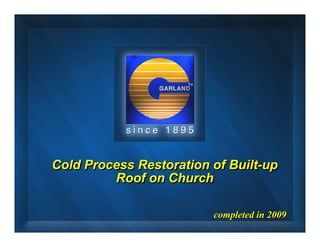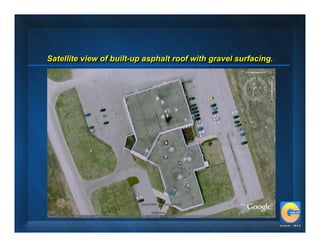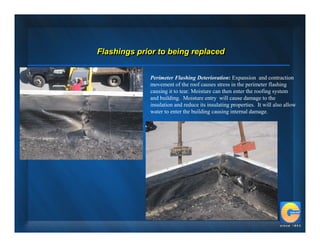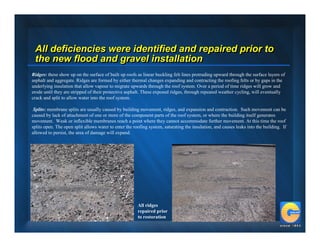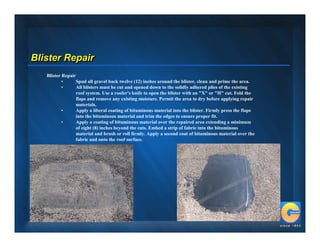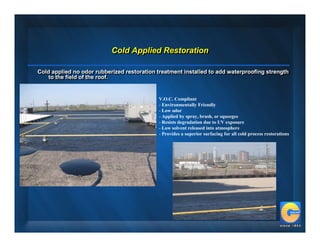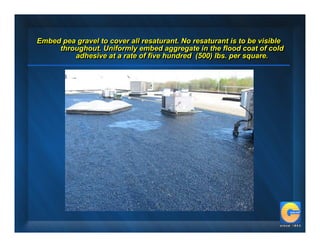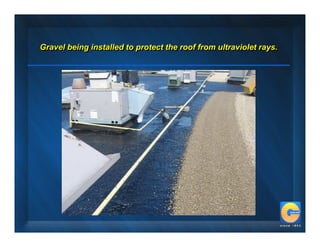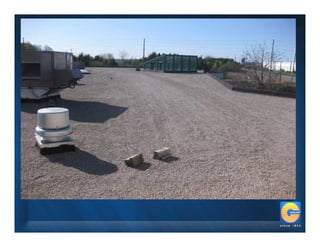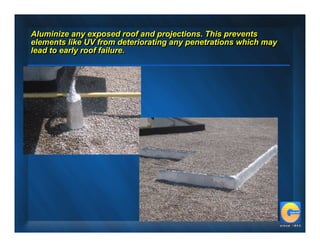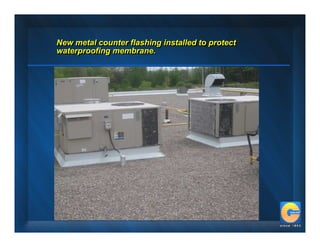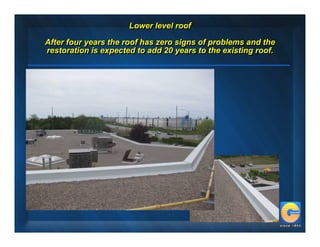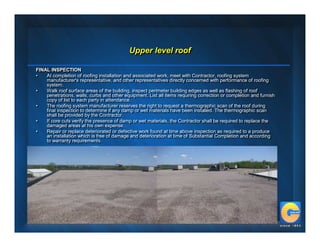Cold process restoration
- 1. Cold Process Restoration of Built-up Built-up Roof on Church completed in 2009
- 2. Satellite view of built-up asphalt roof with gravel surfacing. Satellite view of built-up asphalt roof with gravel surfacing.
- 3. Dry and Wet Vacuuming of existing gravel. Dry and Wet Vacuuming of existing gravel.
- 4. Flashings prior to being replaced Flashings prior to being replaced Perimeter Flashing Deterioration: Expansion and contraction movement of the roof causes stress in the perimeter flashing causing it to tear. Moisture can then enter the roofing system and building. Moisture entry will cause damage to the insulation and reduce its insulating properties. It will also allow water to enter the building causing internal damage.
- 5. All deficiencies were identified and repaired prior to the new flood and gravel installation Ridges: these show up on the surface of built up roofs as linear buckling felt lines protruding upward through the surface layers of asphalt and aggregate. Ridges are formed by either thermal changes expanding and contracting the roofing felts or by gaps in the underlying insulation that allow vapour to migrate upwards through the roof system. Over a period of time ridges will grow and erode until they are stripped of their protective asphalt. These exposed ridges, through repeated weather cycling, will eventually crack and split to allow water into the roof system. Splits: membrane splits are usually caused by building movement, ridges, and expansion and contraction. Such movement can be caused by lack of attachment of one or more of the component parts of the roof system, or where the building itself generates movement. Weak or inflexible membranes reach a point where they cannot accommodate further movement. At this time the roof splits open. The open split allows water to enter the roofing system, saturating the insulation, and causes leaks into the building. If allowed to persist, the area of damage will expand. All ridges repaired prior to restoration
- 6. Blister Repair Blister Repair ŌĆó Spud all gravel back twelve (12) inches around the blister, clean and prime the area. ŌĆó All blisters must be cut and opened down to the solidly adhered plies of the existing roof system. Use a roofer's knife to open the blister with an "X" or "H" cut. Fold the flaps and remove any existing moisture. Permit the area to dry before applying repair materials. ŌĆó Apply a liberal coating of bituminous material into the blister. Firmly press the flaps into the bituminous material and trim the edges to ensure proper fit. ŌĆó Apply a coating of bituminous material over the repaired area extending a minimum of eight (8) inches beyond the cuts. Embed a strip of fabric into the bituminous material and brush or roll firmly. Apply a second coat of bituminous material over the fabric and onto the roof surface.
- 7. Cold Applied Restoration Cold Applied Restoration Cold applied no odor rubberized restoration treatment installed to add waterproofing strength Cold applied no odor rubberized restoration treatment installed to add waterproofing strength to the field of the roof. to the field of the roof. V.O.C. Compliant - Environmentally Friendly - Low odor - Applied by spray, brush, or squeegee - Resists degradation due to UV exposure - Low solvent released into atmosphere - Provides a superior surfacing for all cold process restorations
- 8. Embed pea gravel to cover all resaturant. No resaturant is to be visible Embed pea gravel to cover all resaturant. No resaturant is to be visible throughout. Uniformly embed aggregate in the flood coat of cold throughout. Uniformly embed aggregate in the flood coat of cold adhesive at a rate of five hundred (500) lbs. per square. adhesive at a rate of five hundred (500) lbs. per square.
- 9. Gravel being installed to protect the roof from ultraviolet rays. Gravel being installed to protect the roof from ultraviolet rays.
- 11. Flashings are replaced due to the extreme pressure that exists Flashings are replaced due to the extreme pressure that exists from expansion and contraction of building. from expansion and contraction of building. Base Flashing Ply: Base Flashing Ply: ŌĆō ŌĆō Base Flashing Ply: 40 mil SBS modified Base Flashing Ply: 40 mil SBS modified membrane with woven fiberglass scrim membrane with woven fiberglass scrim reinforcement with the following minimum reinforcement with the following minimum performance requirements according to ASTM performance requirements according to ASTM D5147. Properties (Finished Membrane): D5147. Properties (Finished Membrane): Modified Flashing Ply: Modified Flashing Ply: Modified Membrane Properties (Finished Membranes): Modified Membrane Properties (Finished Membranes): STRESSPLY "E"; ASTM D6162, Type III Grade S STRESSPLY "E"; ASTM D6162, Type III Grade S Tensile Strength (ASTM D5147) Tensile Strength (ASTM D5147) ŌĆóŌĆó 2 in/min. @ 73.4 ┬▒ 3.6┬░F MD 500 lbf/in CMD F 2 in/min. @ 73.4 ┬▒ 3.6┬░ MD 500 lbf/in CMD 550 lbf/in 550 lbf/in ŌĆóŌĆó 50 mm/min. @ 23 ┬▒ 3┬░C MD 87.5 kN/m C 50 mm/min. @ 23 ┬▒ 3┬░ MD 87.5 kN/m CMD96.2 kN/m CMD96.2 kN/m ŌĆō ŌĆō Tear Strength (ASTM D5147) Tear Strength (ASTM D5147) ŌĆóŌĆó 2 in/min. @ 73.4 ┬▒ 3.6┬░F MD 900 lbf CMD 950 F 2 in/min. @ 73.4 ┬▒ 3.6┬░ MD 900 lbf CMD 950 lbf lbf ŌĆóŌĆó 50 mm/min. @ 23 ┬▒ 3┬░C MD 4003 N CMD 4226 C 50 mm/min. @ 23 ┬▒ 3┬░ MD 4003 N CMD 4226 NN ŌĆō ŌĆō Elongation at Maximum Tensile (ASTM D5147) Elongation at Maximum Tensile (ASTM D5147) ŌĆóŌĆó 2 in/min. @ 73.4 ┬▒ 3.6┬░F MD 6.0% CMD 6.0% F 2 in/min. @ 73.4 ┬▒ 3.6┬░ MD 6.0% CMD 6.0% ŌĆóŌĆó 50 mm/min. @ 23 ┬▒ 3┬░C MD 6.0% CMD 6.0% C 50 mm/min. @ 23 ┬▒ 3┬░ MD 6.0% CMD 6.0% ŌĆō ŌĆō Low Temperature Flexibility (ASTM D5147): Low Temperature Flexibility (ASTM D5147): Passes -30┬░F (-34┬░C) F Passes -30┬░ (-34┬░ C)
- 12. Aluminize any exposed roof and projections. This prevents Aluminize any exposed roof and projections. This prevents elements like UV from deteriorating any penetrations which may elements like UV from deteriorating any penetrations which may lead to early roof failure. lead to early roof failure.
- 13. New metal counter flashing installed to protect New metal counter flashing installed to protect waterproofing membrane. waterproofing membrane.
- 14. Lower level roof Lower level roof After four years the roof has zero signs of problems and the After four years the roof has zero signs of problems and the restoration is expected to add 20 years to the existing roof. restoration is expected to add 20 years to the existing roof.
- 15. Upper level roof Upper level roof FINAL INSPECTION FINAL INSPECTION ŌĆóŌĆó At completion of roofing installation and associated work, meet with Contractor, roofing system At completion of roofing installation and associated work, meet with Contractor, roofing system manufacturer's representative, and other representatives directly concerned with performance of roofing manufacturer's representative, and other representatives directly concerned with performance of roofing system. system. ŌĆóŌĆó Walk roof surface areas of the building, inspect perimeter building edges as well as flashing of roof Walk roof surface areas of the building, inspect perimeter building edges as well as flashing of roof penetrations, walls, curbs and other equipment. List all items requiring correction or completion and furnish penetrations, walls, curbs and other equipment. List all items requiring correction or completion and furnish copy of list to each party in attendance. copy of list to each party in attendance. ŌĆóŌĆó The roofing system manufacturer reserves the right to request a thermographic scan of the roof during The roofing system manufacturer reserves the right to request a thermographic scan of the roof during final inspection to determine if any damp or wet materials have been installed. The thermographic scan final inspection to determine if any damp or wet materials have been installed. The thermographic scan shall be provided by the Contractor. shall be provided by the Contractor. ŌĆóŌĆó If core cuts verify the presence of damp or wet materials, the Contractor shall be required to replace the If core cuts verify the presence of damp or wet materials, the Contractor shall be required to replace the damaged areas at his own expense. damaged areas at his own expense. ŌĆóŌĆó Repair or replace deteriorated or defective work found at time above inspection as required to a produce Repair or replace deteriorated or defective work found at time above inspection as required to a produce an installation which is free of damage and deterioration at time of Substantial Completion and according an installation which is free of damage and deterioration at time of Substantial Completion and according to warranty requirements. to warranty requirements.
